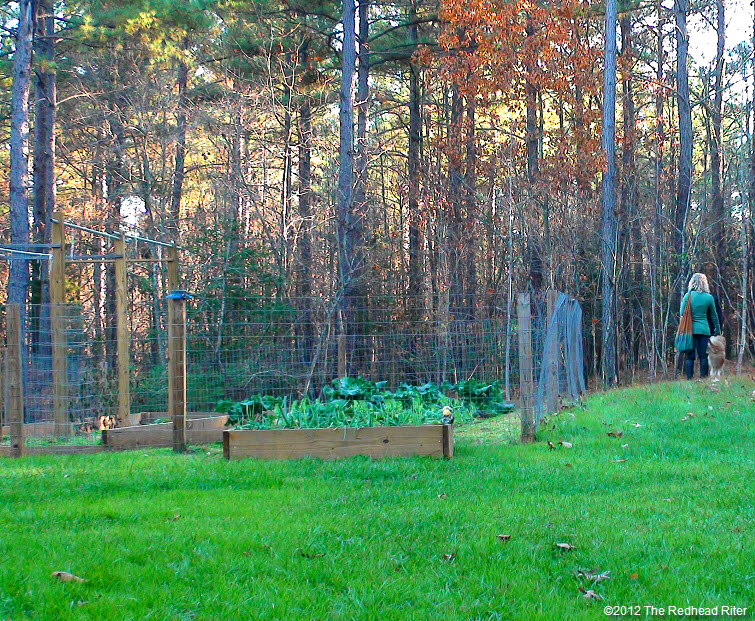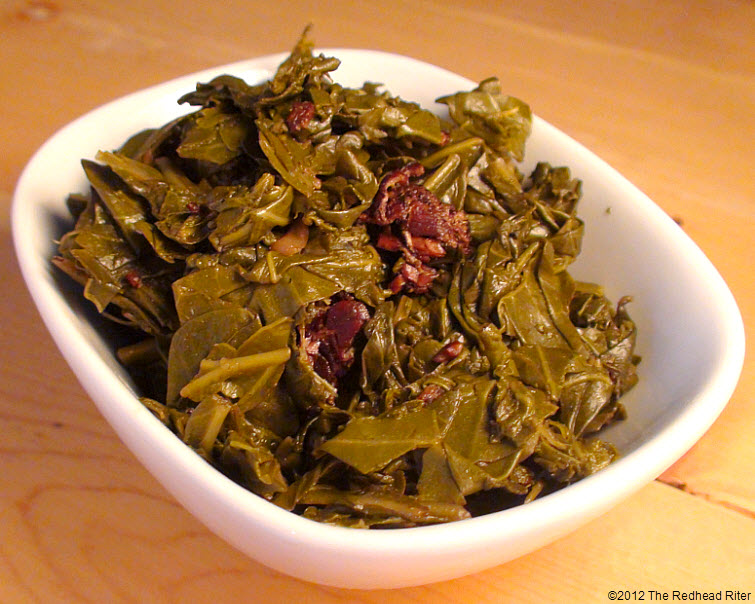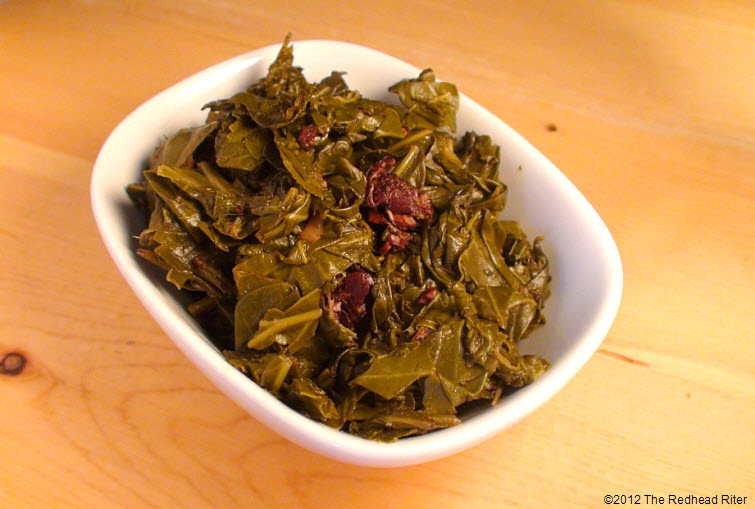Have you ever heard the song Sugartime? It was written by Charlie Phillips and Odis Echols and made famous by The McGuire Sisters when it hit the top of the charts in 1958. Well, to the tune of Sugartime sing this song:
Collards in the mornin’
Collards in the evenin’
Collards at suppertime
Give me a mess o’collards
And I’ll love you all the time!

The Plot Of Earth
From a beautiful plot of earth, a wonderful garden grows and it is cultivated with loving care by my brother-in-law, Terry. I think it would almost be correct to call the garden his “Man Cave” because that’s how much time he spends in it.
Each year in Terry’s garden there are always delicious, brightly colored vegetables. One of the great pleasures in being his sister-in-law is that he unselfishly shares the fruits of his labors in the garden. Part of our Thanksgiving feast was a big o’ mess of collards. To translate for all the non-Southerners, that would be a big pot of collard greens.

My sister said that the two of them were up until 1:00 a.m. on Thanksgiving eve cleaning the collards. Obviously, cleaning big leaves of collard greens is no small task. I guess they should have thrown a collard cleaning party!
What Are Collard Greens? Here’s 14 Facts
Let me take a little step backwards to tell you about collard greens because you might be thinking, “What are collard greens?”
- The word “collard” is derived from the word “colewort” which literally means cabbage plant.
- Collards are loose-leafed plants like a cabbage.
- Collards are grown for their dark green leaves.
- The leaves of the collard plant are very thick
- Uncooked collard greens taste slightly bitter.
- Collard greens are a popular staple in the Southern part of the United States.
- Collard greens are in the same plant family as kale and spring greens.
- The collard plant has an upright stalk and can grow as tall as two feet tall.
- Collard greens are a great source of soluble fiber and vitamin C.
- Collard greens are low in calories as long as you don’t cook them with a bunch of fat!
- The latest research has shown that collard greens are great for the immune system. The cooked greens have anticancer, antiviral and antibacterial properties.
- As far back as 2000 years ago people ate collard greens.
- In the South, a pot of collard greens are usually cooked with a piece of meat such as salted fatback, smoked turkey, ham hocks, hog jowls and bacon.
- When eating collard greens, we usually only add salt, pepper and apple cider vinegar. I also love them with pickled jalapeno peppers!

How To Cook Collard Greens
Although I wasn’t there when Terry cooked the collard greens, I’m pretty sure he probably used the same method that I use, as well as everyone else in my long family line of collard lovers. It is really rather simple to cook collard greens the Southern way. The hardest part of cooking collards is cleaning them.
After all the leaves have been cleaned, just lay them on top of each other. Then roll them up and slice one inch thick slices. The leaves are REALLY big, so it is necessary to cut the leaves to have them cook properly. Place the meat in a LARGE pot with LOTS of water. Add some salt and pepper to taste. Then lay the leaves on top of the meat and start cooking everything on medium. It will take about three hours of cooking in order to get tender collards. Even though my mother will probably turn up her nose, the broth created while cooking the collard greens is delicious too. It makes a great soup broth!
Terry cooked this batch of collard greens with some pancetta and the flavor was delicious! Pancetta is salt cured pork belly meat with peppercorns and is considered to be Italian bacon.
As tedious as it was to clean all the collard leaves, the hardest part was growing the collards. Having a garden requires a lot of devotion and tender care, so I wanted to acknowledge Terry’s efforts today and thank him on behalf of our family.
I brought home some of the wonderfully cooked collard greens we ate at our Thanksgiving meal and for the next two days, I had collards for breakfast, lunch and dinner. It was the one time I was happy that Alyssa didn’t want any! The collards were tender, delicious and had me singing…
Collards in the mornin’
Collards in the evenin’
Collards at suppertime
Give me a mess o’collards
And I’ll love you all the time!
Okay, I’ll admit that’s a bit corny, but what did you expect from a nerdy eGeek?
You know, maybe you should sing it with me and see how good it makes you feel! Everyone together now…
Collards in the mornin’
Collards in the evenin’
Collards at suppertime
Give me a mess o’collards
And I’ll love you all the time! 😉


We grow collards in our Winter garden here in Phoenix. My hubby LOVES them, due to a two year stay in Georgia, so he plants waaaaaay toooo many. So, we dehydrated the leaves, and then ground them up. Now, when I bake my bread, I add 1/4 cup of those dehydrated ground collard greens to my bread dough. It makes awesome bread that I can’t get enough of…and I am NOT a collard green fan. Needless to say, we have at least 9 plants growing in the garden now. Love Collard Bread!
Wow Suzanne! I never even thought of putting collards “in” anything. What a lovely idea! My brain wheels are just burning now! LOL Thanks!
I love collards – & I love your collard song! 😉 I enjoyed delicious collards in Eritrea & Ethiopia, where they are a staple on meatless fasting days.
Here’s some interesting collard info I found on a website devoted to greens:
“Collard greens date back to prehistoric times, and are one of the oldest members of the cabbage family. Collards are also known as tree cabbage or non-heading cabbage, are a cool-season vegetable and extremely nutritious — rich in vitamins and minerals that help prevent and fight disease.
“Greens originated in the eastern Mediterranean, but it wasn’t until the first Africans arrived in Jamestown, Virginia in the early 1600s that America got its first taste of the dark green leafy vegetable. Greens were just one of a few select vegetables African-Americans were allowed to grow and harvest for themselves and their families throughout times of slavery, and so over the years cooked greens developed into a traditional food. Even after the Africans were emancipated in the late 1800s, their love of greens continued, and they kept handing down their well developed repertoire of greens recipes from one generation to the next.
“Though greens did not originate in Africa, the habit of eating greens that have been cooked down into a low gravy, and drinking the juices from the greens (known as “pot likker”) is of African origin. Pot likker is quite nutritious and delicious, and contributes to the comfort-food aspects of the dish.”
Kudos to your brother-in-law for his great garden, & for what looks like a wonderful mess o’ greens! 😀
other African foods that were brought to the States & became major Southern crops & foods include peanuts & okra, both of which were also very common in Eritrea…
I luuuuuuuuuuuv okra!!! Oh my and Alyssa can eat so many batter fried okra. She eats them just like popcorn! LOL
The fact that you love my collard song is proof that you are for sure a nerd too. 😀
I love the pot likker and I know my mother doesn’t at all. LOL
Thanks for such an informative comment! {{hugsss}}
I have never eaten collard greens, but now I am going to have to try them! Meatless, of course! 🙂
They are delicious and so nutritious!
Cool post! This Yankee girl always wondered if I should try collards instead of kale sometime!
Yes! Try it! You’ll like it! Collards are so good!
Singin’ the collard greens song with ya!
LOL We sound great as a duet! 😛